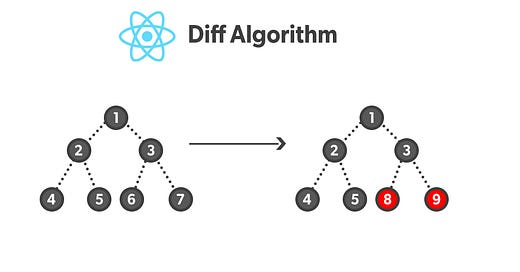Previously :
Intro to Virtual DOM for React Devs
In React, the Virtual DOM (Document Object Model) is a lightweight JavaScript representation of the actual DOM. It is an abstraction that allows React to efficiently update and render components by comparing changes between the current Virtual DOM and a new one.
A diffing algorithm compares two data sets (often represented as trees or lists) to identify differences, enabling efficient updates. In the context of frontend development, especially for libraries like React, it determines the minimal changes required to update the user interface, ensuring the most efficient rendering process.
When to Use:
Diffing is particularly useful in:
Virtual DOM frameworks: For efficiently updating only parts of the DOM that have changed.
Data synchronisation: When working with large datasets that are periodically updated and need comparison.
Version control systems: For comparing file changes across different versions.
Optimising rendering: For UI frameworks, where only minimal changes should be applied to the UI to boost performance.
How to Use:
Identify Components: If you're using a framework like React, the diffing algorithm works by comparing the virtual DOM tree before and after an update.
Compare Structures: The diffing algorithm traverses both trees and checks for differences in node types, properties, and content.
Minimal Updates: Based on the comparison, it only applies the necessary updates to the actual DOM.
Reconciliation Process: In React, for instance, the virtual DOM is reconciled with the real DOM by using diffing to ensure updates are efficient.
But do you really know DOM before Virtual DOM? :
Where to Use:
React / Frontend Frameworks: For rendering UIs, React uses diffing to ensure efficient updates without full re-renders.
Real-time collaborative apps: When multiple users are modifying the same document, diffing helps detect and propagate changes efficiently.
Game Development: For updating game states or scenes based on user input, without redrawing everything.
Pros and Cons:
Pros:
Performance: By only updating changed portions of the DOM, it minimizes the performance hit compared to full page or element re-renders.
Scalability: Efficient for applications with large UIs or datasets, making it more scalable.
Optimised User Experience: Helps in rendering UI changes quickly, resulting in better user experiences.
Cons:
Complexity: The algorithm can be complex to implement and understand, especially for large-scale applications.
Overhead: In some cases, the diffing process itself can introduce overhead if not optimised well.
Initial Setup: Requires thoughtful design and understanding of how to structure data for optimal diffing.
Browser Support:
Browser support for diffing is more related to the libraries or frameworks that implement it, rather than the browser itself. Modern browsers that support JavaScript, such as Chrome, Firefox, Safari, and Edge, will support applications utilising diffing algorithms like React’s virtual DOM diffing.





